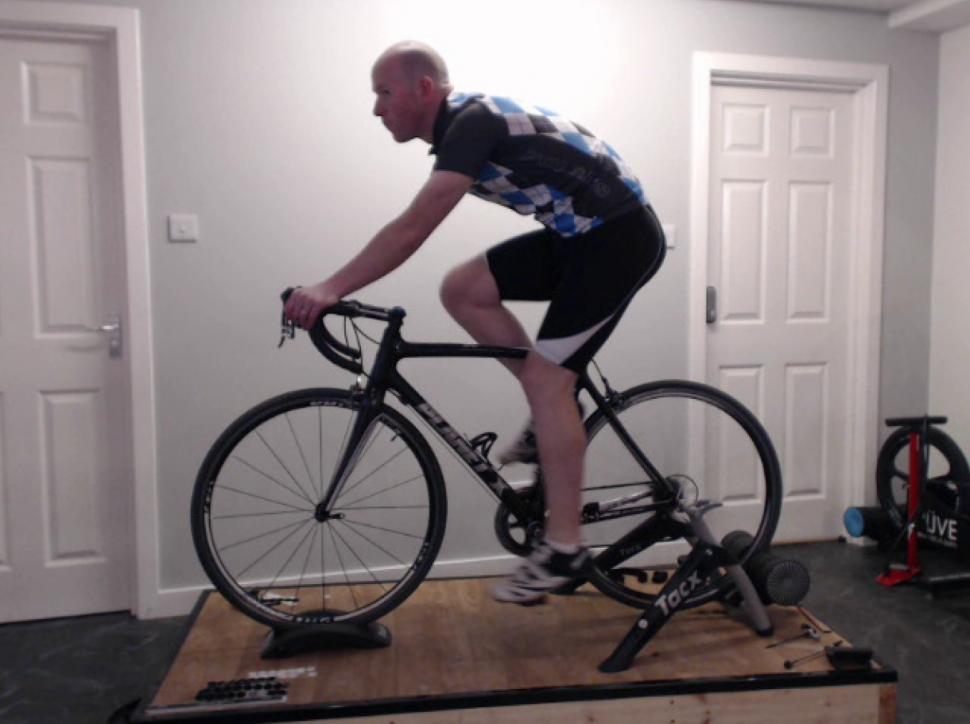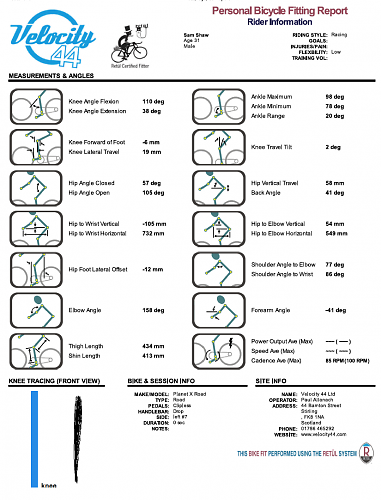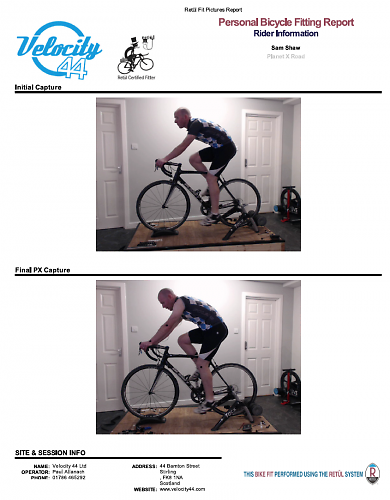- News
- Reviews
- Bikes
- Accessories
- Accessories - misc
- Computer mounts
- Bags
- Bar ends
- Bike bags & cases
- Bottle cages
- Bottles
- Cameras
- Car racks
- Child seats
- Computers
- Glasses
- GPS units
- Helmets
- Lights - front
- Lights - rear
- Lights - sets
- Locks
- Mirrors
- Mudguards
- Racks
- Pumps & CO2 inflators
- Puncture kits
- Reflectives
- Smart watches
- Stands and racks
- Trailers
- Clothing
- Components
- Bar tape & grips
- Bottom brackets
- Brake & gear cables
- Brake & STI levers
- Brake pads & spares
- Brakes
- Cassettes & freewheels
- Chains
- Chainsets & chainrings
- Derailleurs - front
- Derailleurs - rear
- Forks
- Gear levers & shifters
- Groupsets
- Handlebars & extensions
- Headsets
- Hubs
- Inner tubes
- Pedals
- Quick releases & skewers
- Saddles
- Seatposts
- Stems
- Wheels
- Tyres
- Health, fitness and nutrition
- Tools and workshop
- Miscellaneous
- Buyers Guides
- Features
- Forum
- Recommends
- Podcast
OPINION
Get fit, get a bike fit - experiencing Retül
 Sam-Retul-3.png
Sam-Retul-3.pngWe all want to go faster, even if we don’t want to go faster, it’s nice to go faster. Usually cyclists go about this desire for speed by splashing the cash, the more you spend, the lighter upgrades you buy, the faster you go – or in the cast of testers, the more you spend, the more aero the kit is that you’re buying. This is great, we all love new bits, our bike shops love us coming in and wanting new bits, it’s tried and tested. But what about the basics… never mind lighter wheels, aero shoe covers and 667g frames that save you minutes up mountain passes… are you getting the best out of your body?
Choosing
If you’re not sat on the bike in the most efficient position, you’re going to lose power, be uncomfortable and you’ll develop all sorts of aches and pains. I’d been getting a tightness in the small of my back, which I’d put down to being inflexible, so after chatting with a few mates that I ride with, I decided that a bike fit would be a good idea. Now for the choice of what to go for, I’d say that I considered others, but really there was only one choice for me and that was a Retül fit. Why? Because there’s a buzz around about Retül; Team Sky riders are all fitted with the Retül system, it uses computer to create a three dimensional motion capture of your pedalling style and position, plus it’s offered at my local bike shop, Velocity 44 in Stirling. I’m quite lucky because Velocity 44 are the only shop in Scotland to currently offer the Retül system and after a quick chat with the shop owner, Paul Allanach, it confirmed that this was the bike fit I wanted.
Retül offer either a static bike fit – the Retül Müve – or to set you up on your own machine to their three guiding principles: 1. A bike fit must be dynamic; Retül takes a number of measurements over a specified time period whilst you pedal – none of the static plumb-line and tape measure stuff of the past. 2. Measurements must be accurate; the sensors that are placed on your arms and legs are positioned to completely replicate the biomechanics of your body, reducing the risk of a mis-measurement. 3. Once the biomechanics are set, then they must be captured in 3D, 2D is no good, it doesn’t capture the full range of movement that your body moves through whilst pedalling. I wanted the bike fit on both my race and winter bike to make sure that both were set up to the same measurements.
The fit
Firstly, Paul and I had a discussion about the type of riding I want to do, my season and long-term goals, any problems I feel whilst riding and questions about my flexibility, which was fairly poor once Paul had cast his trained eye over me. Paul has gained three levels of Retül fit; UCI Road, TT and Tri. I didn't need the TT or Tri fit, but Paul explained the complexities of what is allowable and how the Retül fit can ensure that your position is not only the most efficient, but also allowable under rules set by governing bodies. We then got set up on the bike, positioned on a turbo trainer set to a manageable wattage and found all the reference points that were going to feed information back to the 3D motion capture sensor sat over on the other side of the room. These reference points are set on seven specific biomechanical junctions to give a detailed 3D image of what your body is doing on the bike. It's achieved by using sticky-backed velcro spots, easy to remove from a shaven leg, but they smart when taking them off a hairy wrist! A wireless LED harness is then attached to the velcro dots; these are the sensors that feed the information back to the computer.
The next stage was to get the motion capture of my position on the bike. This is taken over a pre-determined period (usually 15 seconds) and allows the computer to analyse the angles of your body during a natural pedalling motion. This, for me, was done whilst sat with my hands on the hoods as it's where I spend much of my time when riding. A 3D video is taken on both sides to allow each set of limbs to be analysed and any differences between the two to be addressed. The first motion capture revealed that I wasn't too far off an efficient position. I'm a bit of a micro-adjuster sometimes and I'd spent a while getting this set up to the point where I felt comfortable for long distances. There was, however scope for improvement. My reach was slightly too long with the 120mm stem I was running, and the relationship of my knee to the pedal could be improved.

Retül analysis of my on-bike position
Ch-ch-ch-changes!
The first thing was to raise the saddle and push it forward. I run an in-line seat post so this means that the seat is fairly far forward anyway; Paul explained that raising the saddle height and pushing it forward doesn't cause a huge change in how far my leg is travelling, but it does improve the relationship between my limbs and the cranks. I felt comfortable as soon as the change was made, it was a small tweak, but the bearing of my feet onto the pedals noticeably felt more direct.
Next was the reach... I was in no way sat in an Obree-style “Superman” position, but there wasn't really much bend in my elbow; not great for soaking up bumpy Scottish roads, it also probably explained the stiff neck I would get on longer rides. Paul recommended a shorter, 110mm stem, which was duly fitted. This brought my position back into the parameters that Retül recommends. Immediately, I felt the change. I was able to look up without straining (normally I'd be looking somewhere just in front of my Garmin screen) and I could also reach the drops without feeling my hamstrings straining under the extra extension that was being asked of them. My bars were rotated upwards by a degree or so, just to give extra comfort when riding on the hoods.
Zin and the art of recording bike set-up
Once these two major changes were made to the set-up, my cleat position was adjusted and my reference points taken again in this modified set up. Everything was now falling in the recommended tolerances given by the Retül system, though Paul pointed out that it is the fitter who recommends what changes are required based on the data that they system collects. We did the same process with my winter bike - similar modifications were made, though the cleat position on my winter boots was much further away from where it should've been. Once both bikes had been set up, Paul used the Retül Zin (a handheld digitizer) to send information about the bike set up back to the computer; this gives a full detailed set of measurements that you keep to allow you to set up any bike to the same proportions.
Results
After riding the modified position for a couple of weeks, I can say that the results are evident. The changes made to my bikes weren't huge, however they have made a big difference to my comfort, and power, when riding. The biggest thing is that I can ride on the hoods and be able to keep my head looking forward, rather than down to the area in front of my front hub – a valuable safety improvement if nothing else. Gone are the aching trapezius muscles; comfort is much improved. The ability to ride comfortably on the drops is the best thing about the bike fit. Previously I'd do a mile or two then come back onto the hoods, sometimes grabbing the top of the shifters to get a lower position, this is still achievable but I can happily sit on the drops now, without feeling like I'm trying to contort my body into a position that it really doesn't like.

Before & after images, taken with the Retül Vantage Motion Capture unit
I'd recommend that anyone who has slight discomforts, or just wants a bit more out of their performance to look at getting a bike fit. Retül is currently the only bike fit system that offers 3D analysis, that was important to me; or bodies don't move in two dimensions, they don't always move in one fluid motion, that's where the 3D analysis is extraordinary. I didn't think that moving by small amounts would make such a difference, but it's been a pleasure riding the revised bike position, and the data that comes with the Retül fit will be worth its weight in gold when it comes to purchasing a new bike. Having trust in something that you're going to pay a lot of money for is crucial, cyclists will spend huge amounts on upgrading parts of bikes, new frames, clothing... get a bike fit, you'll gain more from your body than you thought and you'll have the satisfaction of knowing that the next upgrade you buy will fit your on-bike position perfectly.
More Opinion
Latest Comments
- ktache 1 sec ago
Not many animals cause grinding noises when underneath a vehicle.
- eburtthebike 19 min 41 sec ago
I listened to the BBC R4 prog "Should cyclists stay in their lane" and it was pretty much what you'd expect from the BBC, a well-informed cyclist...
- eburtthebike 37 min 33 sec ago
Of course you don't actually want to spend money intended for infrastructure on infrastructure, you want to spend it on plans for infrastructure,...
- Veganpotter 52 min 4 sec ago
My bet is that all these tires popping off are from people with bad pressure gauges or they're simply just putting too much air in on purpose. ...
- Hirsute 1 hour 14 min ago
You have to add images via a reply to yourself after the topic is created. One at a time too.
- Hirsute 1 hour 16 min ago
“Plus, riders who pair CarBack to their smartphone using the Trek Accessory app can enjoy even more features, including the ability to see the...
- Tom_77 1 hour 32 min ago
Had a Kona Blast sometime around the turn of the century, that was a pretty decent mountain bike for not much money....
- chrisonabike 2 hours 7 min ago
David9694 - you were right! These new autonomous vehicles really are conspiring to run out of control!...
- HoarseMann 2 hours 39 min ago
Decathlon have the Garmin Varia RTL515 on offer at the moment for £129.99: https://www.decathlon.co.uk/p/rearview-radar-varia-rtl515-65-lumens/_/R-...
- Rendel Harris 3 hours 49 min ago
So when you said "all Jews" you didn't actually mean all Jews, just religious ones. However even that distinction is erroneous, as you must surely...
Add new comment
10 comments
I had a bike fit with Cadence Sport, ex TDF rider Adrian Timmis which was bought for me as a Xmas gift from the wife.
I was a little concerned that id potentially be several hundred quid worse off after the fit, after being sold different bars, stems etc...but this was certainly not the case
Adrians adjustments overall did seem minor but added up to a dramatically different level of comfort on the bike, to the point where I can comfortably ride in the drops for long periods and on the hoods in complete comfort. I recall his first observations were that I couldnt initially remove my hands from the hoods position and maintain the same pedalling style, but after the fit I could easily do so.
Its an experience?observational based system, not some computer output and feels very individual and personal
There are a lot of people jumping on the BikeFit bandwagon, but theres a reason that Cadence Sport is booked up for several months at a time...Ive never got anything like the performance increase/pound spent out of anything else I've ever bought, and would recommend his fit to anyone
A certain "out of this world" company in South Yorkshire.
Ok! Suitably chastised
@sam, I don't doubt that you feel better for it, but I also think that the pics are the wrong way round. Your arms clearly have a better bend in the first pic, and your head/neck look more comfortable. You sure that is the 'before'?
The pics aren't the wrong way round! They are only a picture and don't tell the full story, the head/neck/arm bend is much comfier in the fitted position.
I had a Retul bike fitting done last year, lasted 40mins. Was told I needed to move up a frame size. So did and ended up with knee and hip pain.
Went back to the old frame and made a few adjustments, 1cm longer stem, seat forward about 1.5cm and slighty lower than suggetsed. Only pain now is the muscles after a long ride. Oh and the £1000 hit in the wallet.
Needless to say slightly sceptical.
40mins???
Name and shame!
I was 4 hours doing my Retul fit was very very through at Cadence at Crystal Palace in South London.
Has improved my cycling two fold.
The problem with a bike fit is that fit changes as you get fitter / less fit / older / more supple / less supple, or your fat increases or decreases, or you change from shorts with a thin shammy to shorts with a thick shammy and tights ... it's actually never a finished item and is always a compromise - so for fitters to pretend that whatever they do is going to provide an ideal riding position is, unless they qualify that carefully, a little disingenuous ...
What a bike fit does do is it allows a rider with relatively little knowledge to benefit from the synthesis of many years of experience of riders, physiologists and coaches to achieve a good starting point.
We see a lot of guys who have been fitted who, unlike the example above, I have to say, look like monkeys on a broomstick at best, with high CoG, poor control and a frontal area that guarantees them minimum kph for maximum effort ... having said that, in the example above, the capture images look as if they are the wrong way around - the initial fit looks a lot more relaxed
Good article cheers. Been thinking about getting a fit done for yonks (even to the point of actually enquiring with a fitter here in Edinburgh who either changed his email address or ignored my mails ) but always been a bit iffy about how reliable such a fit would be. Never heard of Retul till now so that's piqued my interest enough to prod me back into action!
) but always been a bit iffy about how reliable such a fit would be. Never heard of Retul till now so that's piqued my interest enough to prod me back into action!
Is this just a set of your "ideal" offsets and distances e.g. saddle-to-bar distance/vertical offset etc., or do you get some mathematical wizardy with it that'll allow you to punch in frame geometry and whatnot and get a bike-specific list of numbers?
It will allow you to analyse the measurements given for a frame (or allow a bike shop to analyse) so that you can determine what size frame you need and what size stem/bar/seatpost etc. and where they should be set for your fitted size.
I reckon that's just the picture telling lies as I'm much more comfortable post-fit. A follow up should say that my lower back pain (physio told me it was due to hamstrings/glutes) has gone. It wasn't hugely apparent on the bike, but I no longer have a terribly achy back when I'm lying in bed at 5am!
40mins? I didn't even get on the bike within 40mins - are you sure it was a Retül? If so, I'm sure Retül themselves would probably like to know who gave you this fit as their guidelines are pretty strict on the process, a 40min fit isn't right. I agree with gazzaputt - name and shame. Mine lasted 3.5hours.